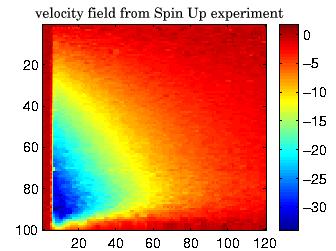Modelling small scales in fluid
dynamics is a main task for geophysicists. In atmospheric physics, the
concept of turbulent diffusivities is largely
used to face that issue and the range of values of this
parameter can be evaluated throught
observation of Ekman layers. As far as the Earth's core is concerned,
such an observation is not possible, so
experimental modelling may help to determine this mixing parameter.
Our experimental apparatus used is a sphere of
radius 11 cm with a central cylindrical pipe. The outer sphere
is heated whereas the central pipe is cooled.
Using an ultrasonic velocimetry doppler technic, we get quantitative
results concerning the fluid velocity when
convection takes place, in gallium as well as in water.
In order to determine turbulent diffusivities,
our experiments consist in quantitatively comparing velocity
fields of purely conductive and convective regimes.
This experiments are Spin up (respectively Spin down) type that
is to say a sudden increase (respectively
decrease) of the rotation speed of the container starting from a state
of
solid body rotation. Through a measure of the
velocity field during the transient time, we deduce a synchronisation
time for each set of experiment. These times
are compared with the theoritical linear prediction made by Greenspan
(1969).
The observations fit perfectly with the theory when
the starting state is purely conductive (experiments without
turbulence). A relatively precise measurement of the
molecular viscosity (within a maximum error of 2\%) is deduced
with that
technique. Comparison with experiments
starting from a convective state superimposed over the body rotation
shows on
one hand that ,for the water, in order to retrieve
the synchronisation time predicted by theory, we need to used a
viscosity up to 43\% bigger than the molecular
viscosity (depending on the vigour of the convection).
On an other hand, experiments using gallium at
higher reynolds number show no significant effects of apparent
viscosity.
Similar experiments performed at Oxford (Atmospheric
Oceanographic and Planetary Physics) using a particules imagery
velocimetry
technic on a cylindrical container forced by thermal
convection between the top and the bottom boundaries show as well a
weak
apparent viscosity effect. Results show that the
apparent viscosity in rapidly rotating system is not only dependant of
the local
Reynolds number but could depend on parameter such
as the Prandlt number.
This priliminary study shows that even if we have
not yet interpreted our results in term of process, through different
experimental appartus we are able to iddentify some
regimes where the apparent viscosity play a major part.







